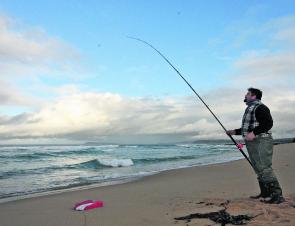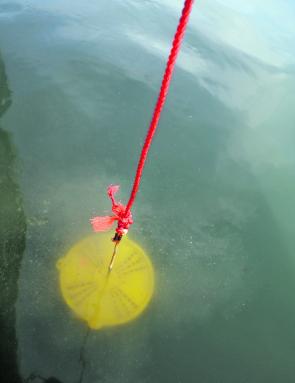In this second instalment of The rules of attractant I will take a look at berleying for the bread and butter species: garfish, Australian salmon and yellow-eye mullet.
Garfish, salmon and yellow-eye mullet might not be the top of the most popular species to target list, but around Victoria’s Coastline there are a lot on anglers that pursue these species regularly.
When it comes to taking your children fishing, boredom can set in quickly, especially if there is no action catching a fish. These three species are a great option for kids to cut their teeth on due to their abundance around the coast.
Garfish are a mid-water feeder, they swim in schools of hundreds if not thousands at times. An option year round, they are caught in Western Port and Port Phillip Bay by land-based and boat anglers alike.
Garfish have only a small mouth so it is imperative that a very fine mixture of berley be used for attracting gars. From a pier or jetty, anglers might notice other anglers using a mixture of water and flour for berley. This is quite inexpensive but has little fishy scent to it. Although it works, a pollard mixture containing fish oils is preferred, such as the South Australian-made Bate Mate branded mix. This is a fine grainy powder that can be squeezed into a ball and tossed out into the water were it breaks up and creates a trail.
Whether you’re on a boat or fishing from the land, this particular berley is downright deadly.
To effectively berley for garfish, a small handful of the berley can be squeezed into a ball about half the size of a golf ball and tossed out into the water. This should be done every 10 minutes to keep the fishy smell in the area. After the trail is established, continue to cast the float set up into the trail and keep the trail going for the duration of the fishing session.
Coming into the surf season, fishing from one of Victorian’s many beaches will become a regular occurrence for land-based anglers throughout the winter period. Many of our beaches are quite long with gutters and strong currents all providing hangouts for salmon to search for food. Take Gunnamatta Beach on the Mornington Peninsula for example, it is approximately 18km in length. In the coming weeks, weekend anglers will head to the beach and cast out one blue bait, whitebait or pipi hoping to catch a fish. On a beach that length, waiting for one fish to sniff out the tasty offering will make it a long day.
Berleying in the surf is a huge benefit and will attract salmon by the hundreds, often right into the shore break turning a long quiet day into an epic mad fishing session.
While some anglers already use berley and have their own mixtures, those wanting to give it a go need to make sure they do it right.
Berleying in the surf requires very little effort. A simple mixture can be placed into, and only into, an onion bag which is then secured to a rope and tied onto a surf rod holder.
The bag can be laid on the beach so that with each wave that washes up the beach gently covers the bag a little taking back the berley into the gutter, thus attracting the fish. All you have to do then is to cast your baits into the trail and hold on.
Mullet are quite an intriguing species to catch. Even though they tend to be caught when whiting fishing in Western Port or in the surf fishing for Australian salmon, specifically targeting them is a lot of fun. The humble mullet might not suit up as a delectable main meal, but when it comes to light tackle, these balls of muscle put your angling ability to the test.
Although mullet tend to be caught as a by-catch, berleying for them is very effective. In Western Port, mullet are rife, especially in the shallows.
One prime location is the Middle Spit, which is more associated with anglers targeting whiting. For mullet, berley can change from using pellets mixed with fish oil and pilchards to just using dry pellets. Mullet are less fussy on smell but more interested in eating something; they are a scavenger rather than a hunter.
Similar to that, when whiting fishing, berley must be put into a berley pot with small holes to regulate the right amount of flow. Too much berley and they will gorge themselves on it often ignoring your baits. Once the pot is loaded, place on the sea floor and let the current disperse it. After a short period of time, if you notice the fish going off the bite or not being as aggressive, the berley pots holes will be blocked and you will have to give it a shake to get it flowing again.
This same berley technique can be used from any of the piers as well. Simply half fill the pot, lower next to a pylon and fish in the trail created.
Regardless of the species being targeted, berley will always work. The reason being, it is a smell in the water that fish will hone in on while searching for a feed. For the extra effort required, berley can dramatically change the way you fish and bring on success. So the next time you hit the beach, pier or out in the boat, take along some berley, the results will astound you.
SURF SALMON BERLEY MIXTURE
1 x 4kg bag of chook (layer) pellets
1 x 500ml bottle of tuna oil (not fish oil)
1 x 1kg bag of pilchards
Mix together well the night before so pilchards are broken into small pieces.
Following morning before leaving, empty mix into onion bag and place into bucket to carry to beach.
MULLEY BERLEY MIXTURE
1 x 2kg bag of chook (layer) pellets.
Half fill berley pot when fishing and place on seafloor. Ensure berley bucket is weighted so it sits directly under the boat and fish baits back into the trail.
5 RULES OF ATTRACTANT
1. When using berley keep the mix as fine as possible based on the species.
2. Always keep the berley trail at a constant flow.
3. Make the berley as fishy as possible.
4. Ensure you have enough berley for your session.
5. Never break a berley trail.
Reads: 2486
For anyone using berley at any land-based location, an onion bag is a great addition. You can place your berley into it, stake it off and let the waves do all the work for you to keep the trail constant.

When using berley in the surf, don’t set the trail and fish further down the beach. Always cast into the trail as this is where the fish will be.

Catching garfish can be a lot of fun for everyone. Berley is essential but ensure it is a fine powder otherwise you’ll fill them up.

From any of the piers in Western Port, a berley pot can be lowered next to the pylons. This is very effective on garfish, mullet, salmon, whiting, silver trevally, pinkie snapper, gummy sharks and plenty more.

Yellow-eye mullet are also attracted by the use of berley. This can be in the form of a pollard mix or pilchards mixed into a berley pot. Either way, the berley must be placed on the seafloor to be effective.

There are some very big mullet about; the berley will attract them so make sure your tackle is up to the challenge.

Don’t underestimate the power of berley when targeting mullet.




